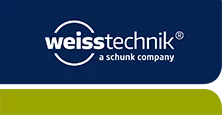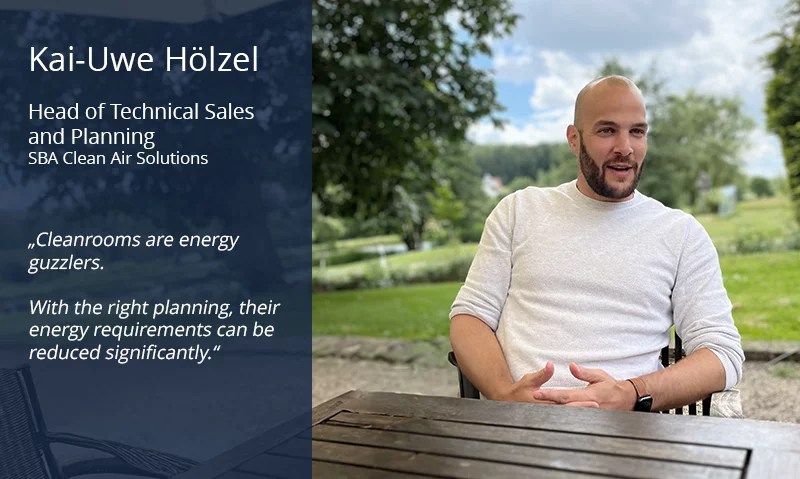Wearing a sweatshirt, jeans and white sneakers: Kai-Uwe Hölzel arrives at the Tech Lunch dressed casually. When speaking, he is engaged and highly focused. Accompanying his concise technical input is a Flammbrot from the wood-fired oven topped with tomato, mozzarella, pepperoni, and spicy salami.
Mr. Hölzel, everyone is talking about energy efficiency. How does that apply to pharmacies?
Sustainability and energy efficiency are definitely important topics for pharmacies. Carbon footprint and energy costs are becoming increasingly important, especially if you have your own production facility with a cleanroom.
What sort of amounts are we talking about here?
It depends on many factors. Annual energy costs for a cleanroom can easily reach six figures. Any savings will significantly improve profitability.
Can pharmacy cleanrooms be energy efficient?
There's no question that cleanrooms require a lot of energy for process-related reasons. However, with the right measures, energy consumption can be reduced by up to 30%. So, yes, cleanrooms in pharmacies can be operated energy-efficiently.
How can the efficiency of pharmacy cleanrooms be improved?
It is crucial to analyze all aspects in detail and derive the appropriate measures. This starts with the product: non-toxic products, such as parenteral nutrition, have different requirements for a cleanroom compared to toxic products, like cytostatics. This opens up a number of possibilities for layout design and energy efficiency. For toxic products, 100% outside air must be used, leaving little room for optimization.
What does 100% outside air mean for efficiency?
Quite simply, cleanroom air must undergo extensive conditioning. First, it is significantly cooled for dehumidification, then heated to the target temperature. This is a very energy-intensive process. For non-toxic products, recirculation allows the conditioned air to be reused, maximizing the efficiency of the energy used. However, this is only partially possible for air contaminated with pollutants. Suitable decoupled circuit-based systems for this purpose have a significantly lower efficiency than systems with recirculation operation.
How else can efficiency in cleanrooms be optimized?
The layout is a critical factor. Designing the cleanroom to meet specific needs - from workstations to corridors and airlocks - can help reduce energy costs over the long term. Unfortunately, cleanroom technology is often over-engineered out of fear of taking risks. With experience and technical expertise, the air exchange rate can be optimized, while taking into account the heat load of the equipment used in the cleanroom, without compromising safety or violating complex regulatory requirements.
What legal requirements need to be considered?
It depends: For standard pharmacies, the Pharmacy Operating Regulations (Apothekenbetriebsordnung) apply. Pharmacies and hospital pharmacies operating as manufacturing facilities fall under Section 13 of the Medicinal Products Act (Arzneimittelgesetz) and, for example, require a monitoring system. It is also important to have a good understanding of the regulator. Even after the revision of Annex 1 / EU-GMP Guidelines, there are regional differences in interpretation. Not understanding this can lead to costly and energy-intensive mistakes that, in the worst case, may prevent the facility's approval.
Are there other adjustments to consider?
Yes. Non-toxic areas should mostly operate with recirculated air. The proportion of outside air should be based on the minimum requirements of the processes involved. The reason for this is that the recirculated air does not have to undergo extensive conditioning. Also, a defined maintenance mode during weekends or vacation periods can reduce air volume by 30–40%, saving energy. Energy efficiency can also be fine-tuned by using special filters with lower air resistance for the same filtration performance. Despite their purchase price, they often pay for themselves within a few years. Under the right conditions, high-pressure spray humidifiers can also reduce energy consumption. These must be suitable for the application and the water quality must be sufficiently good to avoid any risk from contamination.
What else can pharmacists do?
Our cleanrooms also run on photovoltaic power, which allows the pharmacists to optimize their energy consumption, such as electricity, heating and cooling. If they use a heat pump, that's also great, because we can work easily with the lower flow temperatures. They can save a lot here compared to gas or oil. It is best to involve us as early as possible in the planning of a new building or renovation project, so that we can plan everything from the outset in a way that is energy efficient. By the way, external consultants sometimes recommend things that are energy-efficient but technically and legally impossible for pharmacies to implement. We understand pharmacies, products, processes and the legal environment. That is always helpful.
How do you assess the development of energy efficiency in cleanrooms?
Little or nothing can be changed in the production process itself. If a process requires a cleanroom, it will remain energy-intensive. Rising energy costs and growing environmental awareness will increasingly enable us to exploit opportunities to improve energy efficiency. And we have a lot to offer in this area.
Thank you for the interview, Mr. Hölzel, and bon appétit.
A little information about engineer Kai-Uwe Hölzel
After completing his degree in Energy Systems Engineering and a Master's in Mechanical Engineering and Energy Technology, Kai-Uwe Hölzel has been with Weiss Klimatechnik since 2017. As Head of Technical Sales and Planning and an active volleyball player, he is a committed and ambitious team player.

